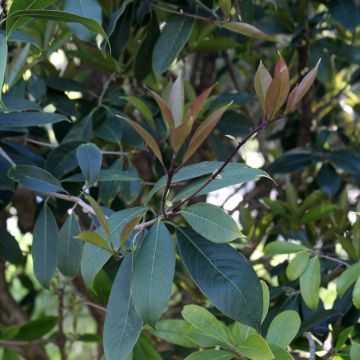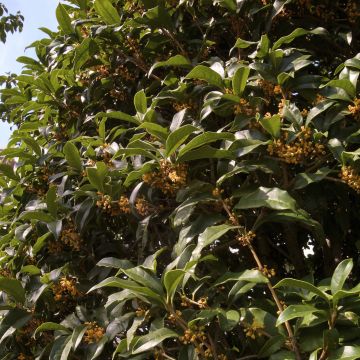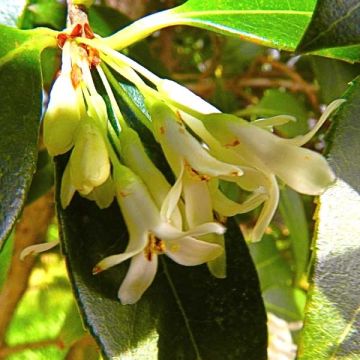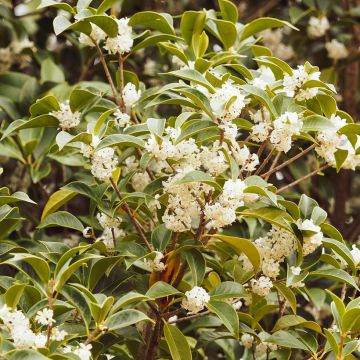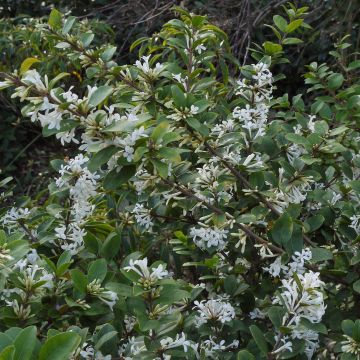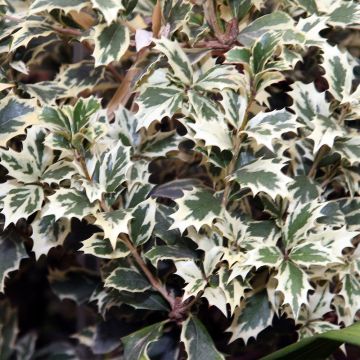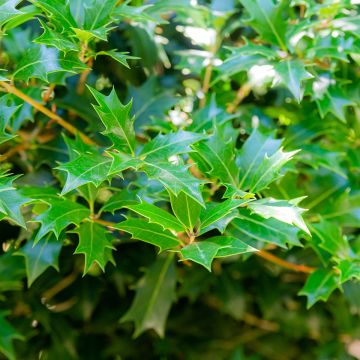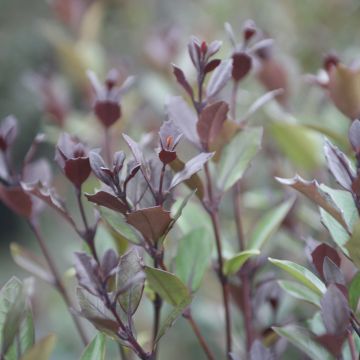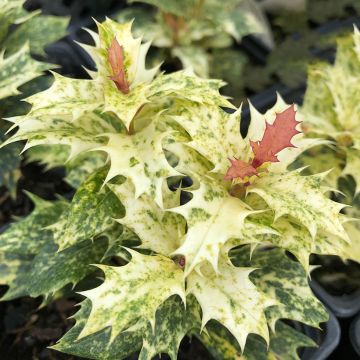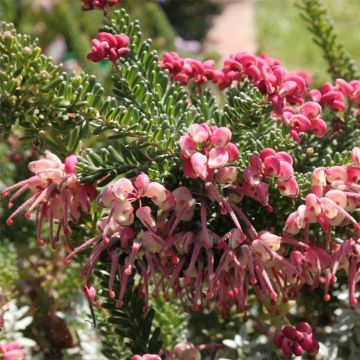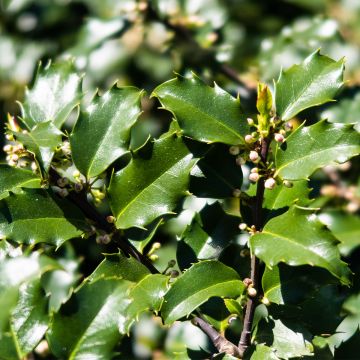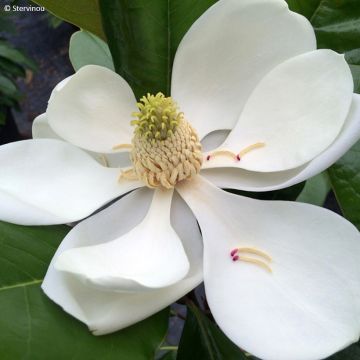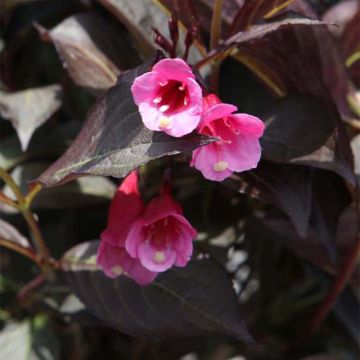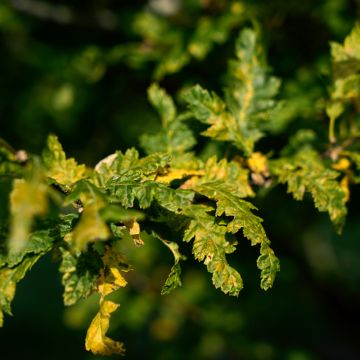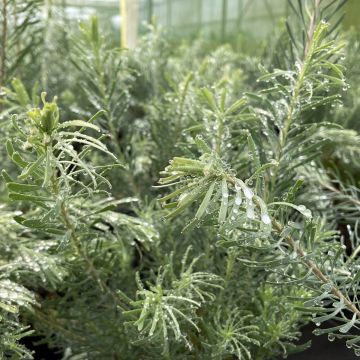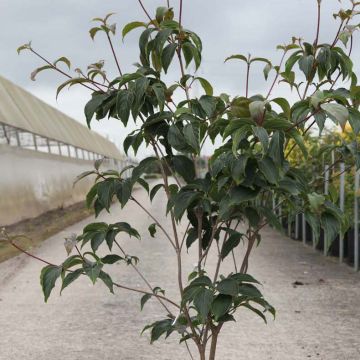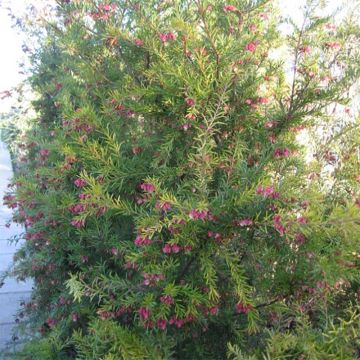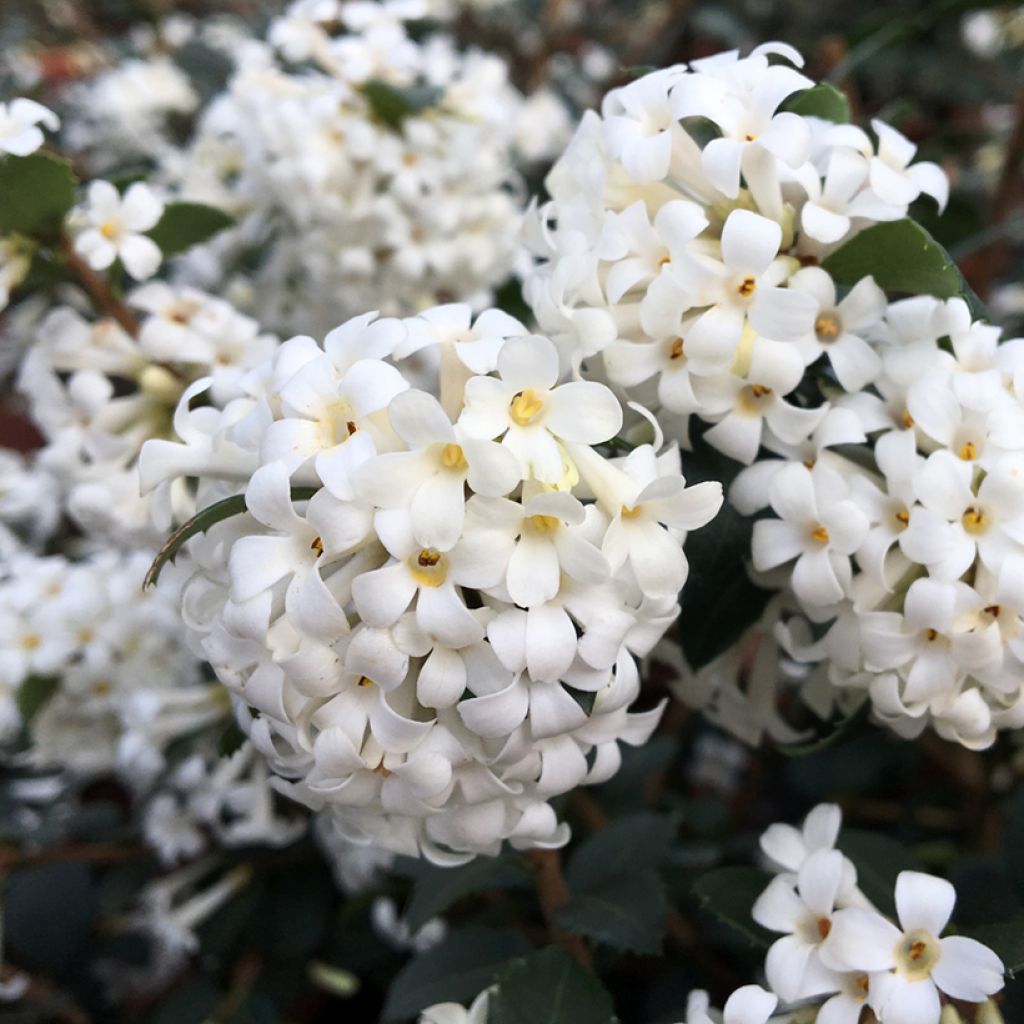

Osmanthus delavayi Perfume of Nature®
Osmanthus delavayi Perfume of Nature®
Osmanthus delavayi Perfume of Nature®
Delavay Osmanthus, Delavay Tea Olive, Fragrant Olive.
This item cannot be shipped to the selected country
Delivery charge from €5.90
More information
Schedule delivery date,
and select date in basket
This plant carries a 24 months recovery warranty
More information
We guarantee the quality of our plants for a full growing cycle, and will replace at our expense any plant that fails to recover under normal climatic and planting conditions.
From €5.90 for pickup delivery and €6.90 for home delivery
Express home delivery from €8.90.
Does this plant fit my garden?
Set up your Plantfit profile →
Description
The Osmanthus delavalyi Perfume of Nature® is a variety that emphasizes the fresh scent, reminiscent of jasmine, of osmanthus. It forms a typical medium-sized bush with late winter flowering in bouquets of small white flowers that are fragrant. Evergreen and adaptable to the soil, it is perfect for hedges, but also for flower beds. Its cultivation should be avoided in the coldest regions.
Osmanthus belongs to the Oleaceae family, which also includes other garden stars such as forsythias, lilacs, and ash trees. Derived from a selection of the Osmanthus delavayi, a Chinese species, Perfume of Nature reaches approximately 3 m in height by 2.5 m wide, and its growth is quite slow. Between February and March, it is covered with small white flowers with four petals, borne in the axils of the leaves, with a strong jasmine-like fragrance. This will perfume your garden in the heart of winter! It is therefore advisable to place the bush near a path, or close to the house, to enjoy it at a time when one is generally less outdoors... It also has small evergreen leaves, dark green, shiny and leathery, slightly dentate, which allow for the creation of a non-intrusive evergreen hedge. Pruning after flowering will help densify it for this purpose.
Fairly tolerant of its environment, the Osmanthus Perfume of Nature thrives in good garden soil, not too heavy, not too sandy, and not too poor. It adapts equally well to partial shade as to sun. Although it tolerates cold down to -15°C, or even lower, it is recommended to protect it from cold winds that could damage its foliage. Like all evergreens, avoid exposing it to the east, as the morning sun could damage the leaves by warming them too quickly after a frost. It forms beautiful rustic hedges alongside shrubs such as Philadelphus Belle Etoile, Abelia Edward Goucher, Berberis thunbergii, Buddleja Nanhoe Purple, Ceanothus Henri Desfossé, or the Deutzia Perle Rose. Vary the flowering times to achieve a colourful display throughout the year!
Report an error about the product description
Plant habit
Flowering
Foliage
Botanical data
Osmanthus
delavayi
Perfume of Nature®
Oleaceae
Delavay Osmanthus, Delavay Tea Olive, Fragrant Olive.
Cultivar or hybrid
Other Osmanthus
Planting and care
Place the Osmanthus Perfume of Nature in full sun or partial shade, avoiding cold winds but providing good ventilation. It is a plant that loves warmth and tolerates coastal conditions very well. Plant it in a regular, rather light, fertile, moist but well-drained soil. It tolerates all types of soil except very dry ones. It is sensitive to intense cold and stagnant moisture. It can be planted all year round, excluding frost periods. Osmanthus plants used for hedges should be spaced 80 cm to 1 m apart. If planted in a container, a depth of 40 cm is required. Osmanthus is easy to grow. Give it a generous watering at planting, i.e. once or twice a week, to promote establishment. Then, continue with regular watering. Prune the branches after flowering to maintain a compact and bushy habit. Additionally, pruning the base helps the soil to stay moist. The bush tolerates hard pruning, although it then takes two years to flower abundantly.
Planting period
Intended location
Care
This item has not been reviewed yet - be the first to leave a review about it.
Striking foliage shrubs
Haven't found what you were looking for?
Hardiness is the lowest winter temperature a plant can endure without suffering serious damage or even dying. However, hardiness is affected by location (a sheltered area, such as a patio), protection (winter cover) and soil type (hardiness is improved by well-drained soil).

Photo Sharing Terms & Conditions
In order to encourage gardeners to interact and share their experiences, Promesse de fleurs offers various media enabling content to be uploaded onto its Site - in particular via the ‘Photo sharing’ module.
The User agrees to refrain from:
- Posting any content that is illegal, prejudicial, insulting, racist, inciteful to hatred, revisionist, contrary to public decency, that infringes on privacy or on the privacy rights of third parties, in particular the publicity rights of persons and goods, intellectual property rights, or the right to privacy.
- Submitting content on behalf of a third party;
- Impersonate the identity of a third party and/or publish any personal information about a third party;
In general, the User undertakes to refrain from any unethical behaviour.
All Content (in particular text, comments, files, images, photos, videos, creative works, etc.), which may be subject to property or intellectual property rights, image or other private rights, shall remain the property of the User, subject to the limited rights granted by the terms of the licence granted by Promesse de fleurs as stated below. Users are at liberty to publish or not to publish such Content on the Site, notably via the ‘Photo Sharing’ facility, and accept that this Content shall be made public and freely accessible, notably on the Internet.
Users further acknowledge, undertake to have ,and guarantee that they hold all necessary rights and permissions to publish such material on the Site, in particular with regard to the legislation in force pertaining to any privacy, property, intellectual property, image, or contractual rights, or rights of any other nature. By publishing such Content on the Site, Users acknowledge accepting full liability as publishers of the Content within the meaning of the law, and grant Promesse de fleurs, free of charge, an inclusive, worldwide licence for the said Content for the entire duration of its publication, including all reproduction, representation, up/downloading, displaying, performing, transmission, and storage rights.
Users also grant permission for their name to be linked to the Content and accept that this link may not always be made available.
By engaging in posting material, Users consent to their Content becoming automatically accessible on the Internet, in particular on other sites and/or blogs and/or web pages of the Promesse de fleurs site, including in particular social pages and the Promesse de fleurs catalogue.
Users may secure the removal of entrusted content free of charge by issuing a simple request via our contact form.
The flowering period indicated on our website applies to countries and regions located in USDA zone 8 (France, the United Kingdom, Ireland, the Netherlands, etc.)
It will vary according to where you live:
- In zones 9 to 10 (Italy, Spain, Greece, etc.), flowering will occur about 2 to 4 weeks earlier.
- In zones 6 to 7 (Germany, Poland, Slovenia, and lower mountainous regions), flowering will be delayed by 2 to 3 weeks.
- In zone 5 (Central Europe, Scandinavia), blooming will be delayed by 3 to 5 weeks.
In temperate climates, pruning of spring-flowering shrubs (forsythia, spireas, etc.) should be done just after flowering.
Pruning of summer-flowering shrubs (Indian Lilac, Perovskia, etc.) can be done in winter or spring.
In cold regions as well as with frost-sensitive plants, avoid pruning too early when severe frosts may still occur.
The planting period indicated on our website applies to countries and regions located in USDA zone 8 (France, United Kingdom, Ireland, Netherlands).
It will vary according to where you live:
- In Mediterranean zones (Marseille, Madrid, Milan, etc.), autumn and winter are the best planting periods.
- In continental zones (Strasbourg, Munich, Vienna, etc.), delay planting by 2 to 3 weeks in spring and bring it forward by 2 to 4 weeks in autumn.
- In mountainous regions (the Alps, Pyrenees, Carpathians, etc.), it is best to plant in late spring (May-June) or late summer (August-September).
The harvesting period indicated on our website applies to countries and regions in USDA zone 8 (France, England, Ireland, the Netherlands).
In colder areas (Scandinavia, Poland, Austria...) fruit and vegetable harvests are likely to be delayed by 3-4 weeks.
In warmer areas (Italy, Spain, Greece, etc.), harvesting will probably take place earlier, depending on weather conditions.
The sowing periods indicated on our website apply to countries and regions within USDA Zone 8 (France, UK, Ireland, Netherlands).
In colder areas (Scandinavia, Poland, Austria...), delay any outdoor sowing by 3-4 weeks, or sow under glass.
In warmer climes (Italy, Spain, Greece, etc.), bring outdoor sowing forward by a few weeks.

































